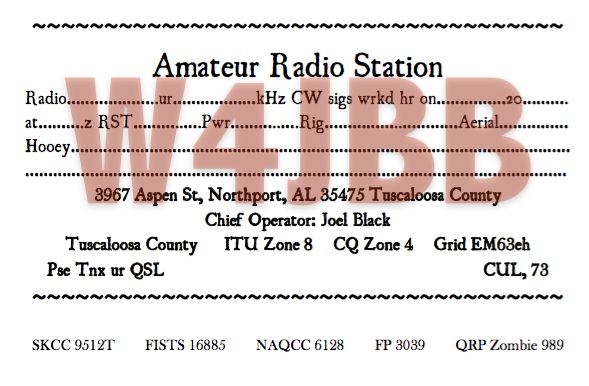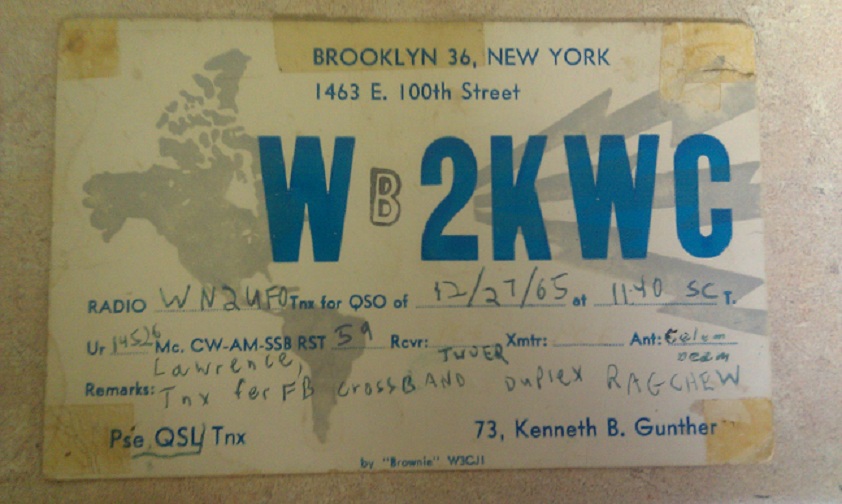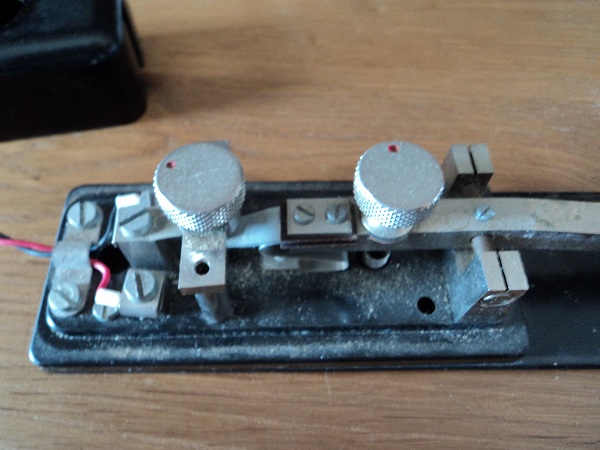
PA3CLQ's Leuke Linken Nr. 422
Don't forget me guys!
72/73 Steve, W1SFR
REM :
I can highly recommend K8RA paddles.
I have one and I LOVE it!!
Andy, K2OO
"Old-Fashioned" QSL
It’s too nice a day in Alabama to not be outside.
I’m only inside for a coffee break and thought I’d ask a question.
Several months ago, I designed a (what I thought to be) nostalgic QSL card.
I would like opinions from some of the old-timers here.
I forget off what I based this card. I generally use LoTW but find myself occasionally waning nostalgic especially when on CW.

73, Joel - W4JBB
REM :
Joel -
I have an image of my 1965 QSL Cards on my webpage:
http://www.ac2c.net/Photo-Album.php
Scroll down to the WN2RTB/WB2RTB Cards.
Also, my younger brother, W2GT, SKCC #15080, also went through some trouble to
recreate the original QSL card for his vanity callsign:
https://www.qrz.com/db/w2gt
73, Ron
REM :
Hello:
The June, 2015 issue of "QNI-The NTS Newsletter," has several scans of QSL cards from the period 1920 to 1941 in it.
They're scattered throughout the newsletter, so in particular, check pages 1, 7 and 17.
https://qninewsletterdotnet.files.wordpress.com/2015/11/qni-2015-6.pdf
73, JW, WB8SIW
REM :
For printing, some locals told me I was silly to use local printers and referred me here:
http://www.ux5uoqsl.com/index.php?lang=en&page=products&cur=wrd
I haven't used them myself, but the referrals seem credible.
Long live CW and paper QSL !
Stephen. ZS6SVJ
REM :

Larry WB2UFO
WHAT IS THIS KEY? (A fairytale)
Hello SK Experts
A Friend gave me this key and i have no clue what it is.
Seems to adjust and operate smoothly
Sorry i have not cleaned it yet.
Any ideas on what it is?
73, Benny K5KV SKCC #1952S


REM :
I wish I had a friend like yours !
The key is an AMPLIDAN marine key.
One of the best.
John / G0RDO / SKCC 2133T
REM :
Wow an Amplidan - lucky you
Warning! This is transmitted over a non secure medium
Mike Kana
REM :
Like the guys said... an Amplidan.
Excellent key used by the maritime service for many years.
Clean it up and enjoy it.
You have been blessed!
73, Ed - ad7gr
REM :
Thanks to those who answered my question.
I truly had no idea it was an Amplidan.
I had heard of this key by name but had no idea i had one.
I can say it is the smoothest hand key i have used.
Some serious cleaning is next
73, BENNY
Bella Toner - Last of the "Paper" Telegraph Operators
Bella Toner (1850-1939) was an employee (station agent and telegrapher) of the Reading RR for 51 years.
She never learned to read by ear, and the Reading kept an embossing paper register in her station until she retired in 1927.
Apparently she was the last "paper" telegrapher on the railroad.
I have posted to the files section a PDF titled "Bella Toner," which is an article just released concerning her in the quarterly journal of the Tredyffrin-Easttown Historical Society of Pennsylvania.
The four pages in the PDF are part of a larger 27-page article on the Philadelphia & Chester Branch of the Reading, which is now a "trail."
The article contains a nice photograph of Bella seated at her paper register.
In the article, Bella is styled as "the oldest living woman telegrapher."
That is mostly public relations department talk, but no one will ever know now, 90 years later.
I first learned about Bella in 1983, when I met Dewey Reber, a 1915-hire Reading RR Telegrapher, Train Dispatcher and Chief Train Dispatcher on the Reading Division.
Dewey had seen Bella operating the paper embossing register shortly after he hired, in 1915.
He told me the register was the last one in use on the Reading RR. After Dewey died, I bought the register from his son, and it came with a matching Camelback key made by the same manufacturer (Knox & Shane of Philadelphia.) Unfortunately, the Camelback key is not visible in the photo.
-- 73 SW & (abram burnett) SlowSpeedWireGroup
REM :
http://www.the2nomads.org/TEHSDocumentStore/miscellaneous.php?keywords=Reading
See attachment pse
Your Editor.
Nice to know from the past.
Braodcast radio from the front to pages 152 and further.
Harley-Davidson $235 page 117
The New Yankee pochet watch $1.50 page120
Underwood Typewriter $3 page 132 a.s.o.
Your editor
4-pin PC Headset connector TRRS port and N1MM audio
Does anyone use a laptop with one of those combination 4 -PIN 1/8" ports that combine mic and stereo headphone audio?
I believe it's called TRRS...nearly looks like your standard 1/8" stereo, but has one extra ring.
I am travelling for a contest later this year and would prefer to take a refurbed Windows-7 IBM Thinkpad L430 (or similar) however it only has this type of TRRS 4-pin ports on it for audio.
Previous computers I've interfaced all have used the discrete in(mic) and out(audio) 1/8" ports on the sound card.
I can get or make an adapter, but I don't really know what goes on internally wrt the sound card and whether there'll be feedback or what-have-you.
I'll probably use one of my old Heil's for the audio.
Thought I'd ask rather than go to the trouble of obtaining a laptop ($$$) (ie: buying one, building a connector and interfacing with a new/different radio only to find out it won't work because of something I haven't thought of.
My plan is to record wav files on the computer and also pipe mic audio through the computer and then out to the radio, then call up those wav files in N1MM and also use my real voice for callsigns, serial #'s etc.
Thanks a lot to whomever has used this cfg and can shed some light !
Mike VE9AA
REM :
Mike,
I am really naive here, but wouldn't what you want just be a Y adapter?
I Googled TRRS splitter and came up with this:
Coboc 3.5TRS4-Y-MFF-1-BK 1 Foot Ultra Slim 3.5mm Stereo 4 pin Male to 2 x Female Headset Y Splitter Cable,Metal Head, Gold Plated - Newegg.ca
http://www.newegg.ca/Product/Product.aspx?Item=N82E16812101105
Gerald, VE1DT
REM :
Mike, I don’t use this configuration, but if it helps, I found this information on pinouts in a quick google search:
laptop computer trrs connector pinout at:
Apparently, the mic input (pin 4) is mono.
But there’s little need to be concerned.
If you buy the laptop and find the internal sound card is too limited or doesn’t work well for you, you can purchase a USB sound card inexpensively.
In fact, that would free you from any annoying Windows sounds being transmitted.
For more on USB interfaces for digital modes, see this informative paper from Jim Brown, K9YC:
http://www.audiosystemsgroup.com/USB_Interfaces.pdf
73, Mark WA9IVH
REM :
Here's are two TRRS to Headphones plug Mic adapters that I bought one each.
Both work fine with my Thinkpads, and probably will work with a
KX3 (haven't tried). I haven't tried to beat them up to test ruggedness.
http://www.amazon.com/BEBONCOOL-Headset-Splitter-Lifetime-Warranty/dp/B00OAQRITQ
I buy a lot of stuff from amazon, and to save shipping costs,
throw stuff into the cart until I hit $49 for free slow shipping.
73, Jim K9YC
REM :
Hi guys and thanks for the replies.
My question was not really about TRRS adapters or how to do it; only if it would work.
Having an input and output device sharing that internal soundcard common connection worries me somewhat (perhaps needlessly).
I like the outboard USB soundcard as a fallback plan though. Hmmm.
Cheers/TNX Mike VE9AA
REM :
> Having an input and output device sharing that internal
soundcard
> common connection worries me somewhat (perhaps needlessly).
You have reason to be concerned IF your station is not properly bonded.
Study my tutorial on Power and Grounding for Ham Radio.
73, Jim K9YC
Signal Propagation Time in the World of MorseKOB Telegraphy
In 1869, scientific tests were conducted to determine the speed of telegraph signals between the East Coast and the West Coast.
The Harvard Observatory, in Cambridge, Mass, and the U.S.
Coast Survey Station in San Francisco served as the end points for this test.
(You can read the details in The Telegrapher, vol. 5, p. 239, March 20, 1869.)
In summary, the results were as follows:
Cambridge to Buffalo and return, thru 1
repeater - 0.10 sec
Cambridge to Chicago and return, thru 3
repeaters - 0.20 sec
Cambridge to Omaha and return, thru 5
repeaters - 0.33 sec
Cambridge to Salt Lake City and return, thru
9 repeaters - 0.54 sec
Cambridge to San Francisco and return, thru
13 repeaters - 0.74 sec
To their credit, the experimenters realized that most of
the delay was probably "armature time," and not true signal
propagation time.
To bring this into the modern world of our
MorseKOB system... Every day when the Noon Time Signal is sent out on Wire 11,
I stand before my Seth Thomas #6 Regulator Clock and watch the second hand at
the telegraphic stroke of Noon.
(Great fun, you know...) And every day I think about the propagation time for Morse signals over the Internet.
Yes, I know that "ping" rate and "latency" are operative categories in the delay, as well as the number of switches the signals must pass through while traveling over the Internet.
Transistors do not change state without the buildup of current to the trigger threshold, and that is not instantaneous.
And my tech-savvy friends tell me that if a signal is
relayed via a satellite, there is 1/2 second "up" time and 1/2 second
"down" time also added to the total signal propagation time.
So, from the time Maurie Challinor closes his
key in New Zealand, to the time my sounder closes, how much real clock time has
elapsed?
From the time the server handling MorseKOB function sends
out the Noon click, to the time I receive it, how much real clock time has
elapsed?
And just where is MKOB's Internet server
located, anyway...?
And do all our MKOB signals move around the world in fiber
optic cable, or are some satellite-relayed?
Hopefully some good engineer with theoretical
proclivities will pen an adroit answer to these questions, so my tormented
conscience can sleep well tonite !
-- 73 SW & (abram burnett)
=============================================================
Sent to You from my Telegraph Key ... better than
AT&T 4G LTE
=============================================================
Posted by: pravoslavna
REM :
Can someone please send me the times that operators gather on the wire?
I had it someplace, but can't locate it.
I'm in the process of building the MorseKOB interface and hope to be able to join the group one day.
73, George
REM :
Hi George,
Well, one of the times is Saturday afternoon, 2PM Eastern time.
So far that's the only time I've managed to be on (and at present, I will be missing a few of them due to other obligations but should be back on eventually).
I think there are several in the evenings during the week, I've heard of one on Monday, but I am not sure of the time, somewhere in the 7PM to 9PM Eastern range I think.
73, Chris Hausler
REM :
Time & wire.
Wire 11 - 8:00 PM CST Monday and Wednesday 1:00 PM CST Saturday
Wire 02 - 7:00 PM CST about every evening I think.
73 - Don
REM :
You can read the following two documents by Les:
https://03a7a917-a-62cb3a1a-s-sites.googlegroups.com/site/morsekob/server/cwcom.pdf
http://kob.sdf.org/morsekob/docs/structure.pdf
73, Chris Hausler MorseKobGroup
REM :
Hi, My first attempt at this would be to use the
WWV time signal dial-up number.
WWV and WWVH Digital Time Code and Broadcast Format at:
http://www.nist.gov/pml/div688/grp40/wwv_format.cfm
NIST claims their accuracy is better than 30ms if
you call from the continental US.
I would then get a dual channel oscilloscope ideally with time A->B
measurement capability.
But - that's not a requirement.
Connect the phone line using an isolation transformer
to scope channel 1.
Connect the telegraph sounder coil to channel 2.
Set the vertical channel sensitivities as needed.
Then set the scope to trigger on the sounder coil voltage toggle.
It might take a few tries so I would start
looking at seconds first to setup the scope horizontal timebase, etc.
Coincident with the sounder toggle, the WWV signal should begin an 800ms tone
at 1500Hz on the hour.
Ideally, the sounder toggle and the start of the 1500Hz tone will happen
simultaneously.
Of course this will not happen and you will now
know to within about 30ms the accuracy of the "Wire 11 Time Signal"
(at your location).
I'm sure more accuracy is possible but with more difficulty and work.
-- 73 Al Heiden
REM :
Abe,
Chris and Chip have given you good information.
Lack of convenient Internet access at my current location (Bacharach on the Rhine) prevents me from adding much more detail, but you might want to take a look at:
http://kob.sdf.org/morsekob/archive/timesignals.htm
it's not up to date, but might be useful anyway.
Generally speaking, the best you can hope for with one of the MorseKOB time signals is about a half second delay.
I could have compensated for this in the sending program, but in the end I decided not to.
It can be interesting to launch two instances of MorseKOB on the same computer and send from one to the other.
The delay you hear is due to intentional buffering in the receiving program.
It's not caused by network delay.
73, Les
REM :
Les, The internal buffer helps to explain a lot of my variation in delays when running more than one copy of MorseKOB.
The separate PC's do have much less delay.
73, Chip
REM :
http://www.morsetelegraphclub.org/
https://groups.yahoo.com/neo/groups/slowspeedwire/info
Software to listening on the wire at:
http://kob.sdf.org/morsekob/morsekob25/index.htm
MorseKOB 2.5 Tutorial: A Guided Tour of the Program at:
http://kob.sdf.org/morsekob/morsekob25/tutorial.htm
Listening to the wire and hear the real original American Morse Code
73, Your Editor
Postal Telegreaph aftrer <-must be after- the Great April 18, 1906 San Francisco Earthquake

Warren McFarland SlowSpeedWireGroup
73, your Editor PA3CLQ
-30-
My simple website about Gigantic DF-Antennas
Part 1 "DF-Antenna Wullenweber Array"
Part 2 "DF-Antenna USSR Variants"
Part 3 "DF-Antenna USA Variant"
Next Part 4 "USSR OTHRA DUGA 1,2 & 3" at: